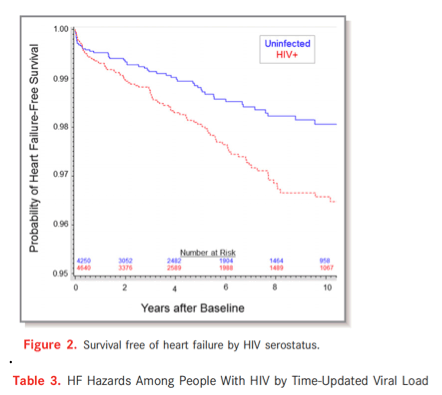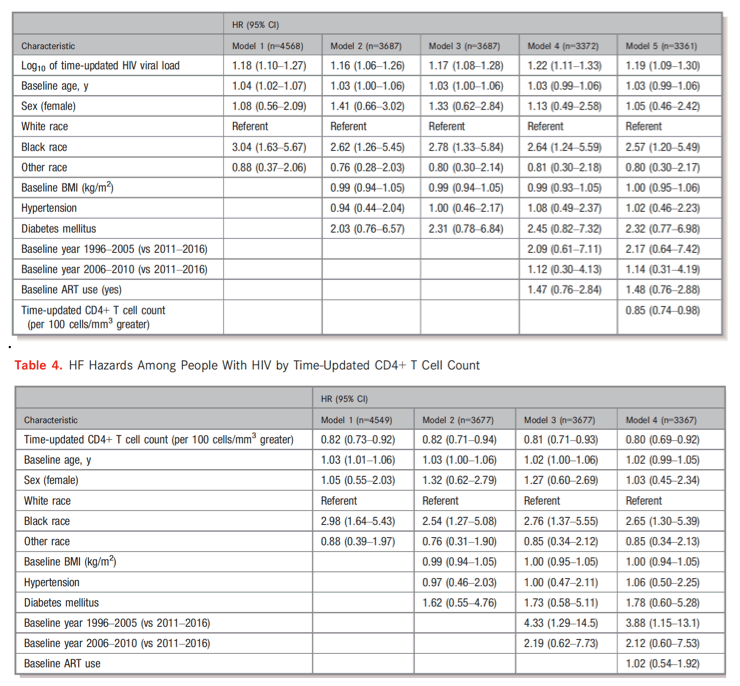| |
Adjudicated Heart Failure in HIV-Infected
and Uninfected Men and Women
|
| |
| |
Download the PDF here
Matthew J. Feinstein, MD, MSc; Alexandra B. Steverson, MD, MPH; Hongyan Ning, MS; Anna E. Pawlowski, MBA Daniel Schneider, MS; Faraz S. Ahmad, MD, MS; Jes M. Sanders, BS; Arjun Sinha, MD; Robin M. Nance, MS; Chad J. Achenbach, MD, MPH;
J. A. Christopher Delaney, PhD; Susan R. Heckbert, MD, PhD; Sanjiv J. Shah, MD; David B. Hanna, PhD; Priscilla Y. Hsue, MD;
Gerald S. Bloomfield, MD, MPH; Chris T. Longenecker, MD; Heidi M. Crane, MD, MPH; Donald M. Lloyd-Jones, MD, ScM
Compared with uninfected people, PLWH also have greater risks for myocardial infarction, arrhythmias, pulmonary hypertension, and subclinical myocardial dysfunction (systolic and diastolic), even after adjustment for traditional cardiovascular risk factors.4
HF risks still appear to be greater among PLWH with low or undetectable viral loads and with CD4 counts ≥500 cells/mm3 than among uninfected controls.14 Taken together, these findings suggest that HIV‐related viremia and immune dysfunction may be implicated in HIV‐associated HF, but other factors appear to be involved as well. Inflammation and immune activation are hallmarks of chronic HIV infection, even in the absence of peripherally detectable HIV viremia,29 and are involved in HF pathogenesis in the general population.35 Although certain ART medications have been implicated in myocardial toxicity36 and associated with elevated rates of HF,14 less is known about the impact of newer antiretroviral therapies on the myocardium and HF risk. Our findings are also consistent with prior studies suggesting that suppression of HIV viral replication with effective ART is associated with lower risk of HF (in addition to preventing noncardiac events).14
We analyzed a nested cohort of HIVE‐4CVD (HIV Electronic Comprehensive Cohort of CVD Complications), which has been described previously18 and consists of PLWH receiving care at Northwestern Medicine and uninfected controls who were frequency matched on age, sex, race/ethnicity, ZIP code of residence, and outpatient clinic location.
Clinical Perspective
What Is New?
• This study is the first to compare incidence of physician‐adjudicated heart failure (HF) for people living with HIV (PLWH) and uninfected controls.
• The hazard ratio for HF (adjusted hazard ratio for PLWH versus uninfected controls: 2.10; 95% confidence interval, 1.38-3.21) was substantially higher than results from recent studies that used administrative (rather than physician‐adjudicated HF) data to ascertain HF; automated definitions of HF may undercapture HF events in HIV.
• Higher HIV viremia and lower CD4+ T cell count were associated with significantly elevated hazards of adjudicated HF.
What Are the Clinical Implications?
• PLWH had significantly higher risk of HF than uninfected people, even in the modern era with most HIV‐infected individuals on HIV therapy; prevention, diagnosis, and treatment of HF are high priorities for PLWH.
• Effective HIV therapy should remain first line for PLWH, as those with poorly controlled HIV had the highest risks of HF.
The Kaplan-Meier estimates of survival free from HF for PLWH versus uninfected controls are shown in Figure 2. On multivariable-adjusted analysis (Table 2), PLWH had signifi-cantly greater hazards of incident HF than uninfected controls, even after adjustment for age, sex, race/ethnicity, baseline BMI, hypertension, diabetes mellitus, year of study entry, and CHD (HR: 2.10; 95% confidence interval [CI], 1.38-3.21). Results were similar when we adjusted for duration of clinical diagnoses (Table S1). There were no significant interactions by race and sex, and when black and white people were analyzed separately, results were highly similar (data not shown).


ABSTRACT
Background
HIV is associated with elevated risk of heart failure (HF). Despite poor agreement between automated, administrative code-based HF definitions and physician‐adjudicated HF, no studies have evaluated incident adjudicated HF for people living with HIV (PLWH).
Methods and Results
We analyzed PLWH and uninfected controls receiving care in an urban medical system from January 1, 2000, to July 12, 2016. Physicians reviewed data from medical records to adjudicate HF diagnoses. We used multivariable‐adjusted Cox models to analyze incident HF for PLWH versus controls and HIV‐related factors associated with incident HF. We also analyzed the performance of automated versus physician‐adjudicated HF definitions. Incident adjudicated HF occurred in 97 of 4640 PLWH (2.1%; mean: 6.8 years to HF) and 55 of 4250 controls (1.3%; mean: 6.7 years to HF; multivariable‐adjusted hazard ratio: 2.10; 95% confidence interval, 1.38-3.21). Among PLWH, higher HIV viral load (hazard ratio per log10 higher time‐updated viral load: 1.22; 95% confidence interval, 1.11-1.33) was associated with greater HF risk and higher CD4+ T cell count was associated with lower HF risk (hazard ratio per 100 cells/mm3 higher time‐updated CD4 count: 0.80; 95% confidence interval, 0.69-0.92). In exploratory analyses, the most accurate automated HF definitions had sensitivities of 67% to 75% and positive predictive values of 54% to 60%.
Conclusions
In a cohort with rigorous HF adjudication, PLWH had greater risks of HF than uninfected people after adjustment for demographics and cardiovascular risk factors. Higher HIV viral load and lower CD4+ T cell count were associated with higher HF risk among PLWH. Automated methods of HF ascertainment exhibited poor accuracy for PLWH and uninfected people.
Modern combination antiretroviral therapy (ART) has transitioned HIV from a fatal progressive disease to a chronic manageable infection marked by noncommunicable disease complications.1 People living with HIV (PLWH) are increasingly at risk for cardiovascular diseases, which may present differently (eg, at an earlier age) and with different underlying risk factors than in the general population.1 Compared with uninfected people, PLWH also have greater risks for myocardial infarction, arrhythmias, pulmonary hypertension, and subclinical myocardial dysfunction (systolic and diastolic), even after adjustment for traditional cardiovascular risk factors.4
Clinically overt heart failure (HF) also appears to be common among PLWH, though data are limited. Seminal analyses of a large cohort of US veterans used administrative codes to find significantly higher rates of HF among veterans with HIV compared with uninfected veterans.13 These studies have been essential to informing knowledge of HF incidence among PLWH in the current era of effective ART but are limited by the predominantly male (>97%) sample and lack of physician‐adjudicated HF end points. Because HF is a complex clinical syndrome requiring combinations of subjective and objective criteria for diagnosis, high rates of disagreement (≥30%) exist between HF administrative codes and physician‐adjudicated HF end points.15 Accordingly, the American College of Cardiology and American Heart Association Task Force on Clinical Data Standards has noted the importance of standardized, adjudicated definitions of HF, given low "concurrence between initial and adjudicated assessment of HF" and "challenges investigators face in classifying HF events."17
No studies to our knowledge have compared HF in PLWH and uninfected controls using physician‐adjudicated HF end points. In a previous cross‐sectional analysis of PLWH receiving care at a large urban medical center with adjudicated HF end points, we found that HIV‐related immunosuppression and viremia were associated with prevalent HF after adjustment for demographics, traditional cardiovascular risk factors, and ART use.18 In the present study, we had the opportunity to evaluate risks for incident adjudicated HF among PLWH and uninfected controls receiving inpatient and/or outpatient care at a large urban medical center. Our central hypotheses were that PLWH would have significantly higher rates of adjudicated HF than uninfected controls and that, among PLWH, low CD4+ T cell count and high HIV viral load would be associated with elevated HF risk.
HIV‐Related Factors Associated With Incident HF
We then restricted our analyses to PLWH and evaluated associations of HIV‐related immunosuppression (time‐updated CD4+ T cell count) and viremia (time‐updated measured HIV viral load) with incident HF. In multivariable analyses adjusted for age, sex, race, baseline BMI, hypertension, diabetes mellitus, year of study entry, and ART use, higher HIV viral load was associated with a significantly greater incidence of HF (Table 3; HR per log10 greater HIV viral load: 1.22; 95% CI, 1.11-1.33). Higher CD4+ T cell count (reflecting less immunosuppression) was associated with a significantly lower incidence of HF after adjustment for the same demographic and clinical covariates (Table 4; HR per 100 cells/mm3 greater CD4+ T cell count: 0.80; 95% CI, 0.69-0.92). When HIV viral load and CD4+ T cell count were included in the same model adjusted for demographics, clinical characteristics, and baseline year, each was associated with a statistically significant difference in HF risk (Table 3; HR per log10 higher HIV viral load: 1.19; 95% CI, 1.09-1.30; HR per 100 cells/mm3 higher CD4+ T cell count: 0.85; 95% CI, 0.74-0.95). In exploratory analyses evaluating clinically relevant categories of CD4+ T cell count, PLWH with baseline CD4+ T cell count <200 cells/mm3 had a borderline greater hazard of HF (HR: 1.84; 95% CI, 0.97-3.50) than those with baseline CD4+ T cell count >500 cells/mm3 (Table S2).
|
|
| |
| |
|
|
|